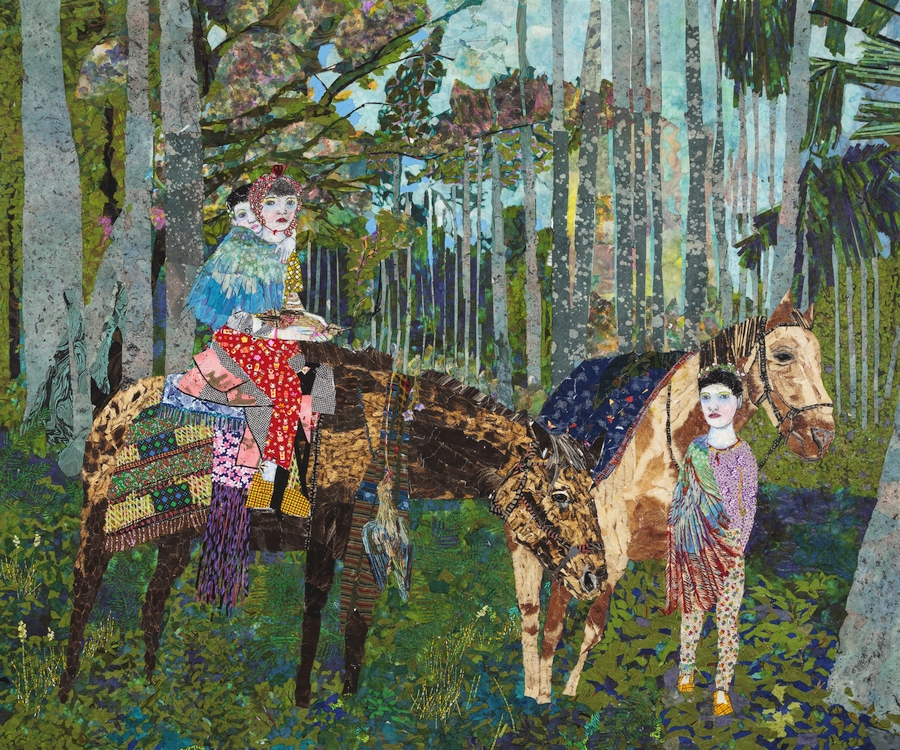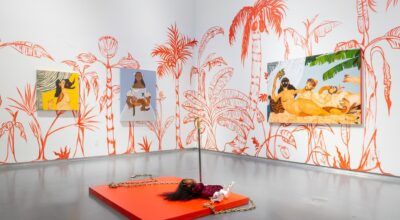
MARÍA BERRÍO: WAITING FOR THE NIGHT TO BLOOM
Based in Brooklyn, New York, María Berrío (1982) grew up in Colombia. Her large-scale works, which are meticulously crafted from layers of Japanese paper, reflect on cross-cultural connections and global migration seen through the prism of her own history. Waiting for the Night to Bloom (Esperando mientras la noche florece) is the first survey of her work, on view until May 9 at the Norton Museum of Art (West Palm Beach, Florida).
Berrío’s large-scale, brilliantly colored collages are meticulously crafted from unique papers sourced from South America and Asia, especially Japan. She creates scenes within the realm of “magical realism,” a hallmark of Latin American literature to which she relates her work.
Lush landscapes and modest domestic interiors are dominated by women who gaze directly at the viewer. The inaction of these ethereal and expressionless characters belies the turmoil and anxiety of their passage to their current surroundings while unflinching in the certainty of their presence. They also characterize Berrío’s own path. Her family history is a testament to the experiences which inspire her subject matter as an immigrant and independent woman in the United States.
She is native to Bogotá, and traveled as a young adult with her family to the US to escape the country’s unstable political climate. When her family returned, Berrío was compelled by her devotion as an artist to remain alone in the US and successfully completed a BFA in 2004 at the Parsons School of Design and an MFA in 2007 from the School of Visual Arts.



Populated predominantly by women, Berrío’s art often appears to propose spaces of refuge or safety, kaleidoscopic utopias which in the past have been inspired in part by South American folklore, where humans and nature coexist in harmony. To these apparently idealised scenes, however, Berrío brings to light the hard realities of present-day politics. For example, Oda a la Esperanza (Ode to Hope) [2019], in which girls appear captive within an institution-like environment, refers to the Trump administration’s family separation policy.
Speaking of the women in her work, Berrío has written: “They are embodied ideals of femininity. The ghostly pallor of their skin suggests an otherworldliness; they appear to be more spirit that flesh. These are the women I want to be: strong, vulnerable, compassionate, courageous, and in harmony with themselves and nature. They combine the elements of women who are typically thought of as powerful – the captains of industry, resolute politicians, fiery activists – with the traits of those who are not usually thought of as such, thereby underlining the common force found in all women.”
MARÍA BERRÍO: WAITING FOR THE NIGHT TO BLOOM
Norton Museum of Art, 1450 S. Dixie Highway West Palm Beach, FL
Through May 9, 2021
También te puede interesar
MADRID ACOGE MUESTRA ANTOLÓGICA DE ALICIA MIHAI GAZCUE
La galería Espacio Minimo, en Madrid, presenta la primera exposición antológica en España de la artista visual Alicia Mihai Gazcue, que incluye trabajos desde 1971 a 2016. Nacida en Uruguay y radicada en Bucarest,...
BONY RAMIREZ: MUSA X PARADISIACA
Behind Ramirez’s muses lie saturated, playful colors, or landscapes of quintessential Caribbean beaches, jungles, and paradisiacal symbols. Accompanying many of his subjects are still lifes with tropical fruits, shells, and plants like the “flamboyant...
Covered in Time And History:the Films of Ana Mendieta
Esta exposición en Martin-Gropius-Bau es la más completa de sus trabajos en film hasta la fecha -va acompañada de tres series de fotografías-, y marca la culminación de un proyecto de investigación conjunta de...



